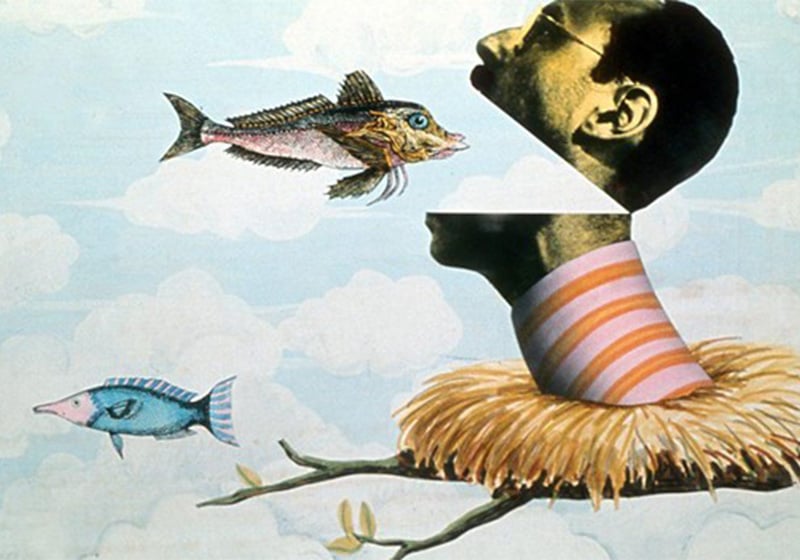Table of Contents
Period photos, bizarre animals, irreverent humour and a dash of nonsense were the ingredients – along with a very personal aesthetic – that made Terry Gilliam’s animations iconic.
His few seconds, or a couple of minutes at most, of pure fun and creative freedom accompanied the TV sketches of British comedy troupe Monty Python in the early 1970s.
Over the years, Terry Gilliam, the creator of these small animated gems, became a permanent member of Monty Python, directed some of the group’s masterpieces and in the decades that followed forged his own film career, churning out other cult films including Fear and Loathing in Las Vegas. When he was creating his fun animations, however, Terry Gilliam was still an up-and-coming creative at the beginning of his career, who had only recently moved to London from America.
Today we’d like to tell you how the Monty Python animations came to be made and how the cut-out technique works, and give you some information about the artist who created them.
Terry Gilliam’s cut-out animations
Technically speaking, Terry Gilliam’s animated collages are called cut-out animations, a two-dimensional version of stop-motion where cut-outs are used just as they are in collages.
The cut-out pieces of paper are positioned on backgrounds (which can either be drawn or collages themselves) and photographed repeatedly, moving each piece a few millimetres each time. During the subsequent editing stage, the images are put into a sequence, creating the illusion of movement.

It is an extremely simple and affordable technique that takes us back to a childlike, free and surreal vision of reality, which is perhaps why we like it so much.
Terry Gilliam’s first cut-out animations appeared in the series Monty Python’s Flying Circus – a sketch show that was broadcast on the BBC from 1969 to 1974. The same technique was then used for the opening titles of several of the British comedy groups feature films, including The Life of Brian (1979) and The Meaning of Life (1983).
In doing so, the artist created the graphical imagery that underpinned the Monty Python world, and became a permanent member of the group. Some people maintain that the surreal appearance of his animations contributed greatly to Monty Python’s appeal and helped them win over younger audiences.
How cut-out animations work
The basic material for cut-out animations is images cut out from magazines and newspapers, illustrations, photographs and postcards. As Terry Gilliam describes in one of his tutorials on this technique, all you have to do is get your hands on anything free or cheap that you can cut out and get to move.
Each character has to be cut into multiple parts so they can move. For example, Terry Gilliam always separates the lower part of the mouth on his faces, to simulate speech. Another important trick is to black the edges of the cut-out images so they stand out against the background.

Using stop motion and a lot of patience, you move each cut-out to be animated a few millimetres on the background then photograph it. A sheet of glass or perspex can help keep the various pieces of paper in the correct position.
In this incredible vintage video, Terry Gilliam himself shows how the cut-out technique works and how to use it to create short films.
As the artist explains, the simplicity of cut-out animations brings with it numerous limitations. For example, it is almost impossible to recreate realistic movements in the characters. But these limitations actually help to stimulate creators’ imagination, leading to results with a surreal and inventive style.
There is also a great deal of scope for improvisation, as Gilliam himself suggests: ‘as soon as you try moving the funny paper characters on the background, you realise that the possibilities are endless’.
Terry Gilliam, an irreverent and stormy artist
In reality, Terry Gilliam never focused too much on the technique he used, but rather the sense of freedom you can enjoy when you start getting creative. ‘The whole point of animation’, he says in an interview, ‘is to tell a story, make a joke, express an idea. The technique itself doesn’t really matter’.
Gilliam, the only American in the group of British comedians, met John Cleese – another original Python – while he was working as a cartoonist at historic American satirical magazine Help!. When the publication closed, Gilliam moved to England, and a few decades later received British citizenship.
As well as his cut-out animations, Terry Gilliam is also famous for several feature films including Time Bandits (1981), Brazil (1985) and Fear and Loathing in Las Vegas (1998). These films have all, for one reason or another, become cult masterpieces, but they almost always experienced huge issues in production. Terry Gilliam’s irreverent and libertarian character, while not appreciated much by producers, is certainly adored by his fans, as shown by this short film that narrates Terry Gilliam’s misadventures, using one of his favourite techniques: cut-out animation.
Terry Gilliam’s animated art and ironic, cheeky messages undoubtedly inspired many people who came after him: consider, for example, South Park’s minimalist animation style (the first series of the cartoon was filmed using cut-out animation) or some of the themes of street artist Banksy.
How about you? Are you already acquainted with Terry Gilliam’s work? And are you ready to follow his advice and experiment with this DIY animation technique ?
Would you like to create your own animations online? Today, you can find numerous animation software for beginners. Discover them all!

